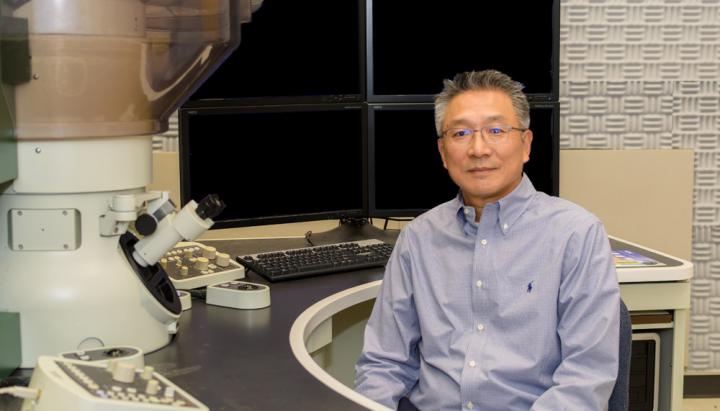UT Dallas researcher’s nanopore sequencing platform detects presence of nucleobases

Credit: The University of Texas at Dallas
Nanopore technology shows promise for making it possible to develop small, portable, inexpensive devices that can sequence DNA in real time. One of the challenges, however, has been to make the technology more accurate.
Researchers at The University of Texas at Dallas have moved closer toward this goal by developing a nanopore sequencing platform that, for the first time, can detect the presence of nucleobases, the building blocks of DNA and RNA. The study was published online Feb. 11 and is featured on the back cover of the April print edition of the journal Electrophoresis.
“By enabling us to detect the presence of nucleobases, our platform can help improve the sensitivity of nanopore sequencing,” said Dr. Moon Kim, professor of materials science and engineering and the Louis Beecherl Jr. Distinguished Professor in the Erik Jonsson School of Engineering and Computer Science.
Currently, most DNA sequencing is done through a process that involves preparing samples in the lab with fluorescent dye and using lasers to determine the sequence of the four nucleobases, the fundamental units of the genetic code: adenine (A), cytosine (C), guanine (G) and thymine (T). Each nucleobase emits a different wavelength when illuminated, allowing scientists to determine the sequence.
In nanopore sequencing, a DNA sample is uncoiled, and the hairlike strand is fed through a tiny hole, or nanopore, typically in a fabricated membrane. As it moves through the nanopore, the DNA strand disturbs the electrical current flowing through the membrane. The current responds differently based on the characteristics of a DNA molecule, such as its size and shape.
“The electrical signal changes as the DNA moves through the nanopore,” Kim said. “We can read the characteristics of the DNA by monitoring the signal.”
One of the challenges in advancing nanopore sequencing has been the difficulty of controlling the speed of the DNA strand as it moves through the nanopore. The UT Dallas team’s research focused on addressing that by fabricating an atomically thin solid-state — or nonbiological — membrane coated with titanium dioxide, water and an ionic liquid to slow the speed of the molecules through the membrane. The water was added to the liquid solution to amplify the electrical signals, making them easier to read.
“By enabling us to detect the presence of nucleobases, our platform can help improve the sensitivity of nanopore sequencing.”
The next step for researchers will be to advance the platform to identity each nucleobase more quickly. Kim said the platform also opens possibilities for sequencing other biomolecules.
“The ultimate goal is to have a hand-held DNA sequencing device that is fast, accurate and can be used anywhere,” Kim said. “This would reduce the cost of DNA sequencing and make it more accessible.”
###
Media Contact
Kim Horner
[email protected]
Original Source
https:/
Related Journal Article
http://dx.




